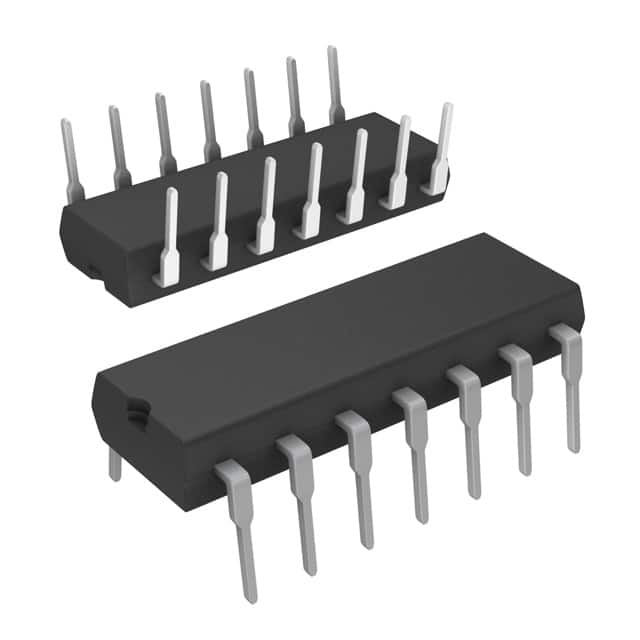Encyclopedia Entry: 74AC14PC
Product Overview
Category
The 74AC14PC belongs to the category of integrated circuits (ICs) and specifically falls under the family of logic gates.
Use
This product is primarily used for signal processing and digital logic applications. It serves as a hex inverter with Schmitt-trigger inputs.
Characteristics
- Hex inverter with Schmitt-trigger inputs
- High-speed operation
- Wide operating voltage range
- Low power consumption
- Compatible with TTL and CMOS logic levels
Package
The 74AC14PC is available in a 14-pin plastic dual in-line package (DIP). The package provides protection and easy integration into electronic circuits.
Essence
The essence of the 74AC14PC lies in its ability to invert input signals while incorporating Schmitt-trigger inputs. This feature ensures reliable and noise-tolerant operation.
Packaging/Quantity
The 74AC14PC is typically packaged in reels or tubes, containing a quantity of 25 or 50 units per package.
Specifications
- Supply Voltage Range: 2V to 6V
- Input Voltage Range: 0V to Vcc
- Output Voltage Range: 0V to Vcc
- Operating Temperature Range: -40°C to +85°C
- Propagation Delay Time: 5 ns (max)
- Input Capacitance: 3 pF (typ)
- Output Current: ±24 mA
Detailed Pin Configuration
The 74AC14PC consists of 14 pins, each serving a specific function:
- Pin 1: Input A1
- Pin 2: Output Y1
- Pin 3: Input A2
- Pin 4: Output Y2
- Pin 5: Input A3
- Pin 6: Output Y3
- Pin 7: Ground (GND)
- Pin 8: Output Y4
- Pin 9: Input A4
- Pin 10: Output Y5
- Pin 11: Input A5
- Pin 12: Output Y6
- Pin 13: Vcc (Supply Voltage)
- Pin 14: Input A6
Functional Features
- Hex inverter operation: The 74AC14PC provides six independent inverters, allowing for versatile signal inversion.
- Schmitt-trigger inputs: The Schmitt-trigger feature ensures noise immunity and hysteresis, making the IC suitable for applications with varying input voltages.
- High-speed operation: With a propagation delay time of only 5 ns, the IC enables rapid signal processing.
Advantages and Disadvantages
Advantages
- Wide operating voltage range allows compatibility with various logic levels.
- Low power consumption makes it energy-efficient.
- Schmitt-trigger inputs provide noise tolerance and reliable operation.
- High-speed operation enables quick signal processing.
Disadvantages
- Limited output current may restrict its use in high-current applications.
- The 14-pin DIP package may not be suitable for space-constrained designs.
Working Principles
The 74AC14PC operates on the principle of digital logic gates. Each inverter within the IC takes an input signal and produces the inverted output. The Schmitt-trigger inputs ensure that the output transitions occur at specific voltage thresholds, providing noise immunity and stable operation.
Detailed Application Field Plans
The 74AC14PC finds application in various fields, including but not limited to: 1. Digital communication systems 2. Microcontroller-based projects 3. Signal conditioning circuits 4. Industrial automation 5. Robotics 6. Sensor interfacing
Detailed and Complete Alternative Models
Some alternative models that offer similar functionality to the 74AC14PC include: - 74HC14: A CMOS version of the hex inverter with Schmitt-trigger inputs. - CD40106: A popular alternative from the CMOS logic family. - SN74LS14: A TTL version of the hex inverter with Schmitt-trigger inputs.
These alternatives can be considered based on specific project requirements, availability, and compatibility with existing circuitry.
Word Count: 550
Lista 10 Vanliga frågor och svar relaterade till tillämpningen av 74AC14PC i tekniska lösningar
Sure! Here are 10 common questions and answers related to the application of 74AC14PC in technical solutions:
Q: What is the 74AC14PC? A: The 74AC14PC is a hex inverter with Schmitt-trigger inputs, which means it can convert low-level signals into high-level signals.
Q: What is the purpose of using the 74AC14PC in a circuit? A: The 74AC14PC is commonly used to clean up noisy or distorted digital signals by providing signal conditioning and improving signal integrity.
Q: Can the 74AC14PC be used for level shifting? A: No, the 74AC14PC is not designed for level shifting. It is primarily used for signal conditioning purposes.
Q: What is the operating voltage range of the 74AC14PC? A: The 74AC14PC operates within a voltage range of 2V to 6V.
Q: How many inverters are there in the 74AC14PC? A: The 74AC14PC consists of six independent inverters.
Q: What is the maximum frequency at which the 74AC14PC can operate? A: The 74AC14PC can operate at a maximum frequency of around 50 MHz.
Q: Can the 74AC14PC be used in both digital and analog circuits? A: No, the 74AC14PC is specifically designed for digital circuits and is not suitable for analog applications.
Q: Does the 74AC14PC have any built-in protection features? A: Yes, the 74AC14PC has built-in ESD (Electrostatic Discharge) protection diodes to safeguard against electrostatic damage.
Q: Can the 74AC14PC be used in high-temperature environments? A: The 74AC14PC has a recommended operating temperature range of -40°C to +85°C, making it suitable for most applications.
Q: Are there any specific precautions to consider when using the 74AC14PC? A: It is important to ensure proper power supply decoupling and avoid exceeding the maximum voltage and current ratings specified in the datasheet.
Please note that these answers are general and may vary depending on the specific application and requirements. Always refer to the datasheet and consult with an expert for accurate information.


